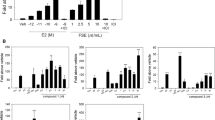Abstract.
The stilbene derivative resveratrol (RES) is a phytoalexin of grapes, peanuts and other fruits. It is structurally related to stilbene estrogens and an estrogenic potential of RES has recently been demonstrated in a number of in vitro studies. In this investigation, the uterotrophic responses of immature Wistar rats to subcutaneous administration of RES (18, 58, and 575 mg/kg) and the reference estrogen ethinylestradiol (EE2; 0.3, 1, 3, 30 µg/kg) on three consecutive days were determined. Uterine weight, histopathological changes, immunohistochemical expression of nuclear estrogen receptor-α (ERα) and progesterone receptor (PR) protein, gene expression of ERα and PR at the messenger ribonucleic acid (mRNA) level and peroxidase induction were examined. EE2 dose dependently increased uterine weight, enlarged the uterine lumen and induced hypertrophy of epithelial, stromal and myometrial cells. Expression of ERα protein in epithelial, stromal and myometrial nuclei and of PR protein in epithelial nuclei was reduced in EE2-treated rats, while PR protein in stromal and myometrial nuclei was increased in a dose-dependent manner. EE2 increased messenger ribonucleic acid (mRNA) levels of uterine PR and induced peroxidase activity. In contrast, RES rather mildly decreased uterine weight, while histology did not reveal differences between controls and RES-treated rats. Expression of nuclear ERα protein was dose dependently decreased in epithelial, stromal and myometrial cells of RES-treated rats, while nuclear PR protein content was similar in controls and RES-treated rats. Following administration of RES, a trend toward reduced levels of ERα and PR mRNA was found, while no peroxidase induction occurred. Plasma levels of RES, 45 min after the administration of a single subcutaneous dose of 500 mg/kg, were in the range 1–2 µM. In summary, an estrogenic potential of RES could not be substantiated in this in vivo study, although the most effective route of administration and extremely high doses were used and plasma levels were in the range reported to be effective in vitro. Whether other pharmacological properties of RES could mediate the observed changes in RES-treated animals is discussed.
Similar content being viewed by others
Author information
Authors and Affiliations
Additional information
Electronic Publication
Rights and permissions
About this article
Cite this article
Freyberger, A., Hartmann, E., Hildebrand, H. et al. Differential response of immature rat uterine tissue to ethinylestradiol and the red wine constituent resveratrol. Arch Toxicol 74, 709–715 (2001). https://doi.org/10.1007/s002040000186
Received:
Accepted:
Issue Date:
DOI: https://doi.org/10.1007/s002040000186




